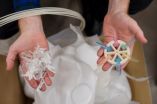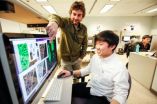(Press-News.org) Millions of high school and college algebra students are united in a shared agony over solving for x and y, and for those to whom the answers don't come easily, it gets worse: Most preschoolers and kindergarteners can do some algebra before even entering a math class.
In a recently published study in the journal Developmental Science, lead author and post-doctoral fellow Melissa Kibbe and Lisa Feigenson, associate professor of psychological and brain sciences at Johns Hopkins University's Krieger School of Arts and Sciences, find that most preschoolers and kindergarteners, or children between 4 and 6, can do basic algebra naturally.
"These very young children, some of whom are just learning to count, and few of whom have even gone to school yet, are doing basic algebra and with little effort," Kibbe said. "They do it by using what we call their 'Approximate Number System:' their gut-level, inborn sense of quantity and number."
The "Approximate Number System," or ANS, is also called "number sense," and describes humans' and animals' ability to quickly size up the quantity of objects in their everyday environments. Humans and a host of other animals are born with this ability and it's probably an evolutionary adaptation to help human and animal ancestors survive in the wild, scientists say.
Previous research has revealed some interesting facts about number sense, including that adolescents with better math abilities also had superior number sense when they were preschoolers, and that number sense peaks at age 35.
Kibbe, working in Feigenson's lab, wondered whether preschool-age children could harness that intuitive mathematical ability to solve for a hidden variable, or in other words, to do something akin to basic algebra before they ever received formal classroom mathematics instruction. The answer was "yes," at least when the algebra problem was acted out by two furry stuffed animals -- Gator and Cheetah -- using "magic cups" filled with objects like buttons, plastic doll shoes and pennies.
In the study, children sat down individually with an examiner who introduced them to the two characters, each of whom had a cup filled with an unknown quantity of items. Children were told that each character's cup would "magically" add more items to a pile of objects already sitting on a table. But children were not allowed to see the number of objects in either cup: they only saw the pile before it was added to, and after, so they had to infer approximately how many objects Gator's cup and Cheetah's cup contained.
At the end, the examiner pretended that she had mixed up the cups, and asked the children -- after showing them what was in one of the cups -- to help her figure out whose cup it was. The majority of the children knew whose cup it was, a finding that revealed for the researchers that the pint-sized participants had been solving for a missing quantity, which is the essence of doing basic algebra.
"What was in the cup was the x and y variable, and children nailed it," said Feigenson, director of Johns Hopkins Laboratory for Child Development. "Gator's cup was the x variable and Cheetah's cup was the y variable. We found out that young children are very, very good at this. It appears that they are harnessing their gut level number sense to solve this task."
If this kind of basic algebraic reasoning is so simple and natural for 4, 5 and 6-year-olds, the question remains why it is so difficult for teens and others.
"One possibility is that formal algebra relies on memorized rules and symbols that seem to trip many people up," Feigenson said. "So one of the exciting future directions for this research is to ask whether telling teachers that children have this gut level ability -- long before they master the symbols -- might help in encouraging students to harness these skills. Teachers may be able to help children master these kind of computations earlier, and more easily, giving them a wedge into the system."
While the ANS helps children in solving basic algebra, more sophisticated concepts and reasoning are needed to master the complex algebra problems that are taught later in the school age years.
Another finding from the research was that an ANS aptitude does not follow gender lines. Boys and girls answered questions correctly in equal proportions during the experiments, the researchers said.
Although other research shows that even young children can be influenced by gender stereotypes about girls' versus boys' math prowess, "we see no evidence for gender differences in our work on basic number sense," Feigenson said.
Parents with numerically challenged kids shouldn't worry that not showing a strong aptitude with numbers is a sign that Bobby or Becky will be bad at math. The psychologists say it's more important to nurture and support young children's use of the ANS in solving problems that will later be introduced more formally in school.
"We find links at all ages between the precision of people's Approximate Number System and their formal math ability," Feigenson said. "But this does not necessarily mean that children with poorer precision grow up to be bad at math. For example, children with poorer number sense may need to rely on other strategies, besides their gut sense of number, to solve math problems. But this is an area where much future research is needed."
INFORMATION:
This research was supported by the National Science Foundation (NSF Living Lab 1113648) and the National Institute of Child Health and Human Development (NIH R01 HD057258).
Developmental Science paper: http://onlinelibrary.wiley.com/doi/10.1111/desc.12177/pdf
Lisa Feigenson: http://pbs.jhu.edu/research/feigenson/
Laboratory for Child Development: http://www.psy.jhu.edu/~labforchilddevelopment/
Are you smarter than a 5-year-old? Preschoolers can do algebra
2014-03-06
ELSE PRESS RELEASES FROM THIS DATE:
Access to social workers could keep veterans out of criminal justice system, MU researchers find
2014-03-06
COLUMBIA, Mo. –Approximately one in six veterans struggles with substance abuse, and 20 percent show signs of mental health issues or cognitive impairments, previous research has shown. These risk factors, combined with a lack of resources, could be contributing to an increase of veterans entering the criminal justice system, according to a report by the Center for Mental Health Services. Now, University of Missouri researchers have investigated ways social workers can address veterans' needs and keep them out of jail.
"Social workers are equipped to provide support to ...
Save money and the planet: Turn your old milk jugs into 3-D printer filament
2014-03-06
Making your own stuff with a 3D printer is vastly cheaper than what you'd pay for manufactured goods, even factoring in the cost of buying the plastic filament.
Yet, you can drive the cost down even more by making your own filament from old milk jugs. And, while you are patting yourself on the back for saving 99 cents on the dollar, there's a bonus: you can feel warm and fuzzy about preserving the environment.
A study led by Joshua Pearce of Michigan Technological University has shown that making your own plastic 3D printer filament from milk jugs uses less energy—often ...
First-ever 3-D image created of the structure beneath Sierra Negra volcano
2014-03-06
The Galápagos Islands are home to some of the most active volcanoes in the world, with more than 50 eruptions in the last 200 years. Yet until recently, scientists knew far more about the history of finches, tortoises, and iguanas than of the volcanoes on which these unusual fauna had evolved.
Now research out of the University of Rochester is providing a better picture of the subterranean plumbing system that feeds the Galápagos volcanoes, as well as a major difference with another Pacific Island chain—the Hawaiian Islands. The findings have been published in the Journal ...
Sickle cell trait: Neglected opportunities in the era of genomic medicine
2014-03-06
(Boston)--While acknowledging the potential of genomics to prevent and treat disease, researchers from Boston Medical Center (BMC) and Boston University School of Medicine (BUSM) believe it is long past due to use current scientific data and technical advances to reduce the burden of sickle cell disease (SCD), one of the most common serious single gene disorders. The work, reported as a Viewpoint in this week's Journal of the American Medical Association (JAMA), highlights the gaps in knowledge and care in terms of SCD and the need to address this issue expeditiously. ...
Physician bias does not affect hypertension treatment for minority patients, says CU
2014-03-06
Doctors' unconscious biases favor whites but do not affect high blood pressure treatment for their minority patients, according to a University of Colorado Boulder study, even though a previous study by the same research group found that doctors' biases are reflected in lower ratings by African-American patients.
The new research, led by Irene Blair, an associate professor in CU-Boulder's Department of Psychology and Neuroscience, is published in the Journal of General Internal Medicine.
"We know that minorities have to face bias and discrimination in many different ...
Astronomers witness mysterious, never-before-seen disintegration of asteroid
2014-03-06
Astronomers have witnessed for the first time the breakup of an asteroid into as many as 10 smaller pieces. The discovery is published online March 6 in Astrophysical Journal Letters.
Though fragile comet nuclei have been seen falling apart as they near the sun, nothing resembling this type of breakup has been observed before in the asteroid belt. NASA's Hubble Space Telescope photographed the demolition.
"Seeing this rock fall apart before our eyes is pretty amazing," said David Jewitt, a professor in the UCLA Department of Earth, Planetary and Space Sciences ...
Hubble witnesses an asteroid mysteriously disintegrating
2014-03-06
The NASA/ESA Hubble Space Telescope has photographed the never-before-seen break-up of an asteroid, which has fragmented into as many as ten smaller pieces. Although fragile comet nuclei have been seen to fall apart as they approach the Sun, nothing like the breakup of this asteroid, P/2013 R3, has ever been observed before in the asteroid belt.
"This is a rock. Seeing it fall apart before our eyes is pretty amazing," said David Jewitt of UCLA, USA, who led the astronomical forensics investigation.
The crumbling asteroid, designated P/2013 R3, was first noticed as an ...
Transplanted human umbilical cord blood cells improved heart function in rat model of MI
2014-03-06
Putnam Valley, NY. (Mar. 6, 2014) – When human umbilical cord blood cells were transplanted into rats that had undergone a simulated myocardial infarction (MI), researchers investigating the long term effects of the transplantation found that left ventricular (LV) heart function in the treated rats was improved over those that did not get the stem cells. The animals were maintained without immunosuppressive therapy.
The study will be published in a future issue of Cell Transplantation but is currently freely available on-line as an unedited early e-pub at: http://www.ingentaconnect.com/content/cog/ct/pre-prints/content-ct0860Chen.
"Myocardial ...
Misplaced protein causes heart failure
2014-03-06
Colchicine, a drug that's used to treat gout, has the beneficial side effect of lowering the risk of heart attack in patients taking it. Conversely, taxol, a drug for treating cancer, has the opposite effect; raising the risk of heart failure.
What both these drugs have in common is that they act on microtubules – a network of fibers inside heart cells that provide internal structural support. Previous studies, including evidence from human patients and experimental models of heart failure, have suggested a link between heart failure and increased density of microtubules, ...
IUPUI researchers use computers to 'see' neurons to better understand brain function
2014-03-06
INDIANAPOLIS— A study conducted by local high school students and faculty from the Department of Computer and Information Science in the School of Science at Indiana University-Purdue University Indianapolis reveals new information about the motor circuits of the brain that may one day help those developing therapies to treat conditions such as stroke, schizophrenia, spinal cord injury or Alzheimer's disease.
"MRI and CAT scans of the human brain can tell us many things about the structure of this most complicated of organs, formed of trillions of neurons and the synapses ...





